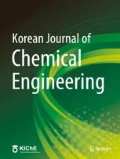Abstract
An ultrasound-negative pressure cavitation extraction method was developed to remarkably improve the recovery efficiency of paclitaxel from Taxus chinensis. The paclitaxel yield was 94–100% through ultrasound-negative pressure cavitation extraction with an extraction time of 3 to 8 min. In particular, most paclitaxel could be recovered within 3 min of extraction at ultrasonic power of 380 W/negative pressure of −260 mmHg. Observation of the biomass surface with SEM before and after extraction showed that as the ultrasonic power and negative pressure increased, the surface was more disrupted. In addition, a pseudo-second order model was suitable for the kinetic analysis, and intraparticle diffusion played a dominant role in the overall extraction rate according to the intraparticle diffusion model. As the ultrasonic power and negative pressure increased, the extraction rate constant (6.8816–11.6105 mL/mg·min), the effective diffusion coefficient (1.550×10−12–11.528×10−12 m2/s), and the mass transfer coefficient (2.222×10−7–5.149×10−7 m/s) increased.
Similar content being viewed by others
References
L. Zhu and L. Chen, Cell. Mol. Biol. Lett., 24, 40 (2019).
M. Caillaud, N. H. Patel, A. White, M. Wood, K. M. Contreras, W. Toma, Y. Alkhlaif, J. L. Roberts, T. H. Tran, A. B. Jackson, J. Poklis, D. A. Gewirtz and M. I. Damaj, Brain Behav. Immun., 93, 172 (2021).
Y. S. Jang and J. H. Kim, Biotechnol. Bioprocess Eng., 24, 529 (2019).
M. Ghorbani, F. Pourjafar, M. Saffari and Y. Asgari, Meta Gene, 26, 100800 (2020).
T. Sun, Y. Liu, M. Li, H. Yu and H. Piao, Mol. Cell. Probes, 53, 101602 (2020).
B. Modarresi-Darreh, K. Kamali, S. M. Kalantar, H. Dehghanizadeh and B. Aflatoonian, Eurasia J. Biosci., 12, 413 (2018).
S. H. Pyo, H. J. Choi and B. H. Han, J. Chromatogr. A, 1123, 15 (2006).
H. J. Kang and J. H. Kim, Process Biochem., 99, 316 (2020).
H. W. Seo and J. H. Kim, Process Biochem., 87, 238 (2019).
J. H. Kim, C. B. Lim, I. S. Kang, S. S. Hong and H. S. Lee, Korean J. Biotechnol. Bioeng., 15, 337 (2000).
G. J. Kim and J. H. Kim, Korean J. Chem. Eng., 32, 1023 (2015).
H. J. Kang and J. H. Kim, Biotechnol. Bioprocess Eng., 25, 86 (2020).
H. J. Kang and J. H. Kim, Korean J. Chem. Eng., 36, 1965 (2019).
K. W. Yoo and J. H. Kim, Biotechnol. Bioprocess Eng., 23, 532 (2018).
J. H. Kim, Korean Chem. Eng. Res., 58, 273 (2020).
G. Chen, F. Bu, X. Chen, C. Li, S. Wang and J. Kan, Int. J. Biol. Macromol., 112, 656 (2018).
M. Rakshit and P. P. Srivastav, J. Food Process. Preserv., 45, e15078 (2020).
W. Tang, B. Wang, M. Wang and M. Wang, J. Appl. Res. Med. Aromat. Plants, 25, 100331 (2021).
R. Upadhyay, G. Nachiappan and H. N. Mishra, Food Sci. Biotechnol., 24, 1951 (2015).
F. Filianty, IOP Conf. Ser.: Earth Environ. Sci., 443, 012104 (2020).
S. Roohinejad, M. Koubaa, F. J. Barba, R. Greiner, V. Orlien and N. I. Lebovka, Trends Food Sci. Technol., 52, 98 (2016).
A. C. Soria and M. Villamiel, Trends Food Sci. Technol., 21, 323 (2010).
Z. Tan, Q. Li, C. Wang, W. Zhou, Y. Yang, H. Wang, Y. Yi and F. Li, Molecules, 22, 1483 (2017).
H. J. Kang and J. H. Kim, Biotechnol. Bioprocess Eng., 24, 513 (2019).
S. Langergren and B. K. Svenska, Veter. Hand., 24, 1 (1898).
L. Rakotondramasy-Rabesiaka, J. L. Havet, C. Porte and H. Fauduet, Sep. Purif. Technol., 54, 253 (2007).
Y. S. Ho, H. A. Harouna-Oumarou, H. Fauduet and C. Porte, Sep. Purif. Technol., 45, 169 (2005).
W. J. Weber and J. C. Morris, J. Sanit. Eng. Div. Am. Soc. Civ. Eng., 89, 31 (1963).
R. Y. Krishnan and K. S. Rajan, Sep. Purif. Technol., 157, 169 (2016).
R. Y. Krishnan, M. N. Chandran, V. Vadivel and K. S. Rajan, Sep. Purif. Technol., 170, 224 (2016).
L. Rakotondramasy-Rabesiaka, J. L. Havet, C. Porte and H. Fauduet, Sep. Purif. Technol., 76, 126 (2010).
G. Wang, Q. Cui, L.-J. Yin, Y. Li, M.-Z. Gao, Y. Meng, J. Li and S.-D. Zhang, Sep. Purif. Technol., 244, 115805 (2020).
D. Panda and S. Manickam, Appli. Sci., 9, 766 (2019).
S. Li, A. Wang, L. Liu, G. Tian and F. Xu, Food Sci. Biotechnol., 28, 759 (2019).
T. Wang, N. Guo, S.-X. Wang, P. Kou, C.-J. Zhao and Y.-J. Fu, Food Bioprod. Process., 108, 69 (2018).
M. Dular, T. Požar, J. Zevnik and R. Petkovšek, Wear, 418-419, 13 (2019).
D. Kavitha and C. Namasivayam, Bioresour. Technol., 98, 14 (2007).
Acknowledgements
This work was supported by the National Research Foundation of Korea (NRF) grant funded by the Government of Korea (MSIT) (Grant Number: 2021R1A2C1003186).
Author information
Authors and Affiliations
Corresponding author
Rights and permissions
About this article
Cite this article
Min, HS., Kim, HG. & Kim, JH. Ultrasound-negative pressure cavitation extraction of paclitaxel from Taxus chinensis. Korean J. Chem. Eng. 39, 398–407 (2022). https://doi.org/10.1007/s11814-021-1028-5
Received:
Revised:
Accepted:
Published:
Issue Date:
DOI: https://doi.org/10.1007/s11814-021-1028-5


